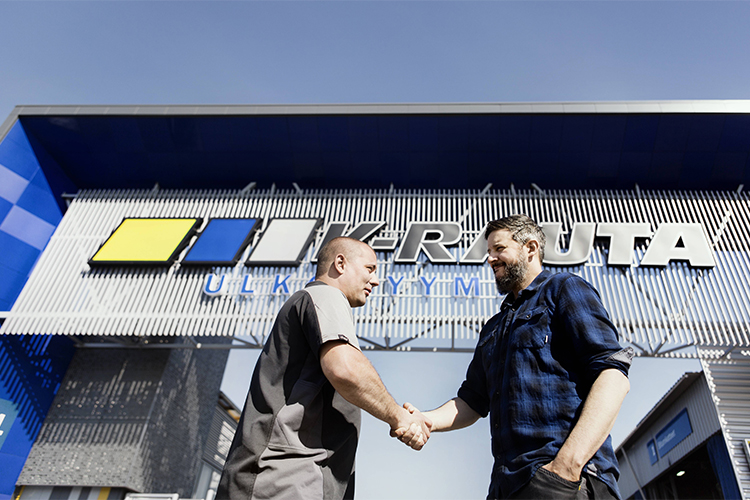

Trademaker
Trends, phenomena, service and tips for everyday life - for shopping to be fun.
Science and technology are advancing ever more rapidly. Change is inevitable; the only ambiguity that remains is its magnitude.

According to a study by Gartner that was widely covered in the media last spring, an astonishing 51% of Finnish business decision-makers do not believe that digitalisation will affect their business, although we have already witnessed how technological development and its indirect effects have broken down established business models in highly traditional sectors. Indeed, we should not ignore the multiplier effects of technological advances, since many developments have hinted at future changes in, for example, consumer behaviour.
Over the past decade, we have seen how social media has brought us closer to each other and increased our communication. Thanks to smartphones and high-speed mobile connections, we are price-conscious when we go shopping, and we base our purchasing decisions on product reviews made by other customers. Generally speaking, we trust other people more than we trust businesses, and we listen attentively to the opinions voiced in our networks. We expect companies to be open and transparent in everything they do because we have access to information anytime and anywhere.
Since we are used to always getting answers easily, we have become more impatient: we expect better and better service and ready-made solutions from the companies that serve us. When planning our Christmas grocery shopping, we would like the supermarket to know in advance what we need, and we hope the retailer has made good choices and picked interesting new products for us without receiving any requests from us. These solutions are enabled by customer data, which has generated considerable public discussion.
Every customer is different, and that is why data collection is essential for excellent service. As customers, we want to receive service that has been tailored to our specific needs: rewards, useful benefits, interesting recommendations and solutions that will make our lives easier. However, we do not want businesses to have access to our personal data if we feel we will not get anything out of it. For this reason, companies need to develop useful data-driven service models for their customers, ensuring they deliver value to customers in exchange for data. Sufficient privacy protection is also a clear trend: we prefer to submit data only to organisations that deserve our trust. However, in many cases it is impossible for humans to draw conclusions from data without any help. We need machines that can process and analyse big data – and become better at this every day.
The dream about self-steering cars has been around since the days of Knight Rider, but this year they have received more attention than ever. Many car manufacturers have promised to take fully autonomous cars into serial production in the 2020s, but the US-based Tesla, which has vowed to include full autopilot capabilities in its cars as early as 2018, has been most in the limelight. According to statistics released in early October, Tesla cars, which are constantly connected to the Internet, have already collected 350 million kilometres of self-driving data. This means that Tesla cars are continuously learning more about how to drive at a given junction or in a specific situation. When the full autopilot feature is released as a software update for cars already manufactured by Tesla, there will be a huge amount of driving experience behind it. Small wonder then that in a test video recently published by Tesla, the autopilot seemed to be entirely at ease driving in an urban environment, and even found itself a free parking space.
With self-driving cars around, fewer and fewer of us will want to own a car and keep it sitting idle in a parking space. PricewaterhouseCoopers has estimated that a minuscule one percent of all cars in the US could handle all driving needs if the cars were used actively instead of being stored in car parks. Among the expected multiplier effects of autonomous driving is a decrease in hotel occupancy rates and railway and air traffic, since self-driving cars will enable drivers to sleep on the way to the destination. If cars and mobility services are provided by companies in the future, the car insurance business will also be faced with a transformation.
How will all this affect shopping? In many ways, although we do not, of course, know what the exact end result will be. In the future, technology will offer us solutions to problems of whose existence we are unaware today. At K-Group, we have already prepared for future shopping trends – because the one thing that is certain is that change will never again be as slow as it is today.
Juha Hotti, Head of Mobile, Kesko, K Digital
Jussi-Pekka Erkkola: Co-creating Digital Customer Experience in a Physical Store
The retail business is transforming due to e-commerce, digital services and the changing customer behavior. It is important that stores are a part of the digital experience, because the store is still the place to create the WOW effect for customers.

Kesko has DIY and home improvement stores in Finland and also in other countries K-rauta being the our international chain brand. We are heavily investing in the technical side of digital development but also building the culture and mindset across the whole company and our partners.
Help salesperson to help customers improve their homes
If you think about common challenges customers have related to DIY and home improvement, one of the most common one relates to difficulty to visualize and show how different product combinations and solutions look in customers own home and how to compare the pricing of these different solution.
For the sales personnel the challenges usually circle around how to add more value to customer by selling solutions with service products like installation or design services.
Our sales personnel face following types of situations and questions daily:
- What the customer needs and wants right now? Are they building a new home? Are their kids moving out and the spare room needs new purpose? Have they bought a renovators dream apartment with 80s style?
- Do we know who the customer is? Have they bought something from us before? What other furniture, designs, colors etc. they have already in their home? What are their favorite colors, materials, designers and brands? What is their budget? What is their family like? Are they professional builders? What are their hobbies and interests?
- Have they already been looking at something in our web site or even added products to the ecom shopping cart? Did they come because they saw an ad or got personal offer from us in some print or digital form? Are they here to just collect items they purchased online?
- How do I communicate solutions to the customer? What products go well together? What does it cost? Will it fit to customers room? What are the unique selling points of the particular product or solution?
- Why would a specific product or range of products be the best solution for this customer? How will it look in customers home or room?
- What do we answer when customers inquire about products? Do we have this thing the customer ask about? How is the product used? What they are good for? How to take care of them? What is the stock balance or availability? What else the customer needs with this specific product? How have other customers used the product? Is there any examples? What are available spare parts?
- Can we assist customers by offering value adding services? Do they have a car or do they need a delivery service? How experienced are they installing or using the products themselves? Do they need help in interior design?
As you can see there are multiple different situations where we can serve our customers even better. Thats why we would like you to come up with service ideas to help our sales personnel or customers in store. Finding new innovative ways to help our customers is one of the main reasons why we want to participate co-creation events like Junction Hackathon on Nov 25-27, 2016
Your Junction 2016 Challenge - we hope you choose to accept
We at Kesko have tried to look in to the crystal ball every now and then. This video below shows what we thought about the future 2 years ago. Some of it is already in the past and some things look quite different.
In Junction Hackathon we are sponsoring the eCommerce & Retail track and we want you to help us to build the future of retail.
During the Juntion Hackathon weekend we would like you to come up with a tool or service for the salesperson to help the customer. It should solve the list of some of the challenges the sales person or customer is facing in store.
Your solution could be:
- Mobile app, dashboard or a tool for the sales person
- Digital experience for the customer (e.g. Virtual Reality, Augmented Reality, Artificial intelligence / cognitive)
- Solution should be usable in-store to drive in-store sales. Keep in mind that customers journey is usually starting and ending at home. Support one or more parts of the customers journey.
Help the sales person to create the best customer experience together with the customer. As you know, deciding what kind of kitchen you want to have or which power tools are right for you is not always an easy task. Digital tools or experiences should help to find the best solutions for the customer. Even if we are developing digital soulutions try to bring up the human touch.
We want you to succeed
During the event you will have access to product data and 3D models of living rooms and kitchens etc.
We will have Kesko personnel, retail store personnel and 3D model exports e.g. from Say duck http://sayduck.com/ helping you out during the event.
Got questions or want to meet us and others before the event?
Want to team up and meet others? Join us on 9th of November in a pre-event organized in co-operation with Product Tank Helsinki. Sign up here so we know how much beverages and snacks we shouls reserve http://www.meetup.com/ProductTank-Helsinki/events/234091181/
If you have any questions, please be in contant and send us a message.
Jussi-Pekka Erkkola, Development director, ecommerce & digital services, Kesko, Building & Technical Trade
Outi Nylund: So that I get exactly what I want
Customers want businesses to offer them more personalised benefits,
services and experiences. According to a Forbes Insights survey, three out of
four consumers in the USA want to receive more closely targeted and personally
meaningful benefits in return for the personal information collected on them.

On the other hand, nearly 90% of the companies that already personalise customer encounters to some extent based on customer data tell about the positive effects of targeting on their business operations, such as an increased conversion rate and customer engagement as well as the development of customer experience (Researchscape 2015).
Customer loyalty programmes have always been based on customer data and its use in marketing and business development. Why is it still challenging for companies to leverage customer data so that every single customer would feel that they get personal service tailored to their specific needs on a daily basis?
One of the main reasons is the absence of the basic element, namely customer data needed for personalisation. Sufficient and correct customer data enables a complete picture of the customer to be built. Data is often siloed in different channels or at points of customer encounter, which makes it challenging to build a sufficiently good, real-time overall picture of the customer. In addition, data is available in various sources, both inside and outside the company, among which the data most significant to business operations should be identified.
Although digitisation has enabled companies to reach the customer personally in digital environments, there is little understanding and competence in leveraging new technologies. It is still easy to understand and adopt the benefits of a single technology. But creating a sufficiently good and comprehensive customer experience requires competencies in many different technologies and an understanding of the kind of technology combination and architecture produces the best possible result.
What competencies and skills does a company need to be able to personalize customer encounters in the desired way with the help of technology and data? After finding the answer, the company has to be able to invest in resourcing these competence areas. After that, the most difficult thing is to update the operating models and organization correspondingly, because the development of the customer encounter at the different points of the customer route will not succeed if the old operating models are not abandoned.
A good example from the world of a K-food store: an enormous amount of customer data is available and it can be leveraged in many ways. Nevertheless, vegan customers receive special offers in digital environments targeted based on their diet, but they also get untargeted special offers of sausages direct to their homes.
There are some examples of a good personalised customer experience at a specific stage of the customer’s path. The online store Amazon is well advanced offering personalised, customer data based product recommendations, and the music service Spotify with ”this week’s recommendations just for you.” Likewise, the K-ruoka mobile app offers weekly its customers exactly those products at lower prices which the customer would buy anyway – the application also recommends products that could interest the customer on the basis of the data.
There are many places in the K-Group where people work on customer data leverage, even if we have only started. In that work, we need to look far into the future. The work is challenging but at the same time very rewarding. Providing personalised service to the customer at the K-Group’s physical stores as well as digital environments has been placed in focus. I’m lucky to be part of this development work, taking customer experience to a completely new, personalised level.
Outi Nylund, Customer Relations Director, K Digital Kesko
Anni Ronkainen: Feeling digital? - Digitisation here and now
An increasing number of traditional businesses are taking significant steps on the path towards digitisation. What does digitisation actually mean? Why is it perhaps one of the greatest transitions fuelled by technology in the history of mankind?

There is no single definition of digitisation, but in general, it is used to refer to digital renewal – anything that can be digitized is digitized and integrated in our daily lives. Over the years, consumers have seized the opportunities enabled by technology, whereas businesses have a lot to catch up.
Digitisation has an overall impact on the operations of businesses and their existing structures. It challenges the current earning logic and the traditional operating models.
Digitisation concerns all sizes of businesses in all lines of business and businesses have only two alternatives in responding to this change: either they seize the opportunities enabled by digitization and build it into a competitive advantage, or they don’t and lose the competition.
Digitisation is not, however, a mere exercise in technology. Technology enables the change, but the change itself arises from somewhere else altogether, namely from us people. But the interesting thing is how we embrace new technology and make it part of our daily lives.
Digitisation concerns us all. It has irrevocably changed our behaviour at both work and leisure. New technology and digital services have permanently changed the way we are, live and consume.
Digitisation has a strong impact on business culture. It does away with hierarchical barriers and adds transparency and openness to the organization. Digitisation forces businesses to decentralise decision-making and authorises teams to assume ownership. A successful organisation responds quickly, tries out new things and is not afraid of making mistakes.
The digital transformation does not happen by itself, it needs active management. Above all, management is about managing change at all levels of the organisation. It means building new skills, demolishing rigid silo-like structures and increasing cooperation an all levels. Enabling fast response and action is the lifeblood of an organisation.
We have the privilege of witnessing this big transition – witnessing how technology changes the world and improves the quality of life for even billions of people. No similar transition will take place during our lifetimes. The work we do in the K-Group influences the daily lives of all Finnish people. That keeps our attitude humble.
Anni Ronkainen, Chief Digital Officer, SVP, Kesko